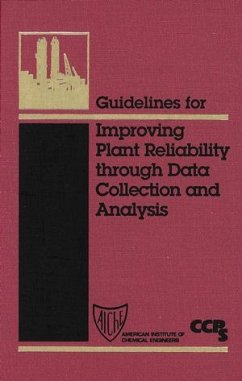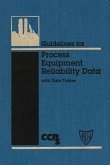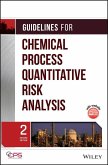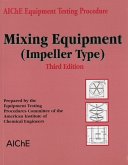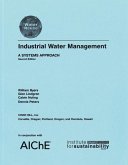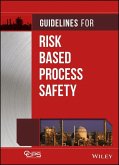Ccps (Center For Chemical Process Safety)
Guidelines for Improving Plant Reliability Through Data Collection and Analysis (eBook, PDF)
185,99 €
185,99 €
inkl. MwSt.
Sofort per Download lieferbar

0 °P sammeln
185,99 €
Als Download kaufen

185,99 €
inkl. MwSt.
Sofort per Download lieferbar

0 °P sammeln
Jetzt verschenken
Alle Infos zum eBook verschenken
185,99 €
inkl. MwSt.
Sofort per Download lieferbar
Alle Infos zum eBook verschenken

0 °P sammeln
Ccps (Center For Chemical Process Safety)
Guidelines for Improving Plant Reliability Through Data Collection and Analysis (eBook, PDF)
- Format: PDF
- Merkliste
- Auf die Merkliste
- Bewerten Bewerten
- Teilen
- Produkt teilen
- Produkterinnerung
- Produkterinnerung

Bitte loggen Sie sich zunächst in Ihr Kundenkonto ein oder registrieren Sie sich bei
bücher.de, um das eBook-Abo tolino select nutzen zu können.
Hier können Sie sich einloggen
Hier können Sie sich einloggen
Sie sind bereits eingeloggt. Klicken Sie auf 2. tolino select Abo, um fortzufahren.

Bitte loggen Sie sich zunächst in Ihr Kundenkonto ein oder registrieren Sie sich bei bücher.de, um das eBook-Abo tolino select nutzen zu können.
Written by reliability data experts, the book gives plant managers and supervisors the guidance they need to collect, and use with confidence, process equipment reliability data for risk-based decisions. Focusing on the process industries, it provides the protocol and techniques to collect and organize high quality plant performance, maintenance, and repair data from your own operations, and includes methods and examples on how the data can be converted into useful information for engineering, maintenance, safety, and loss prevention. This data can be used for: facility…mehr
- Geräte: PC
- ohne Kopierschutz
- eBook Hilfe
Andere Kunden interessierten sich auch für
![Guidelines for Process Equipment Reliability Data, with Data Tables (eBook, PDF) Guidelines for Process Equipment Reliability Data, with Data Tables (eBook, PDF)]() Ccps (Center For Chemical Process Safety)Guidelines for Process Equipment Reliability Data, with Data Tables (eBook, PDF)168,99 €
Ccps (Center For Chemical Process Safety)Guidelines for Process Equipment Reliability Data, with Data Tables (eBook, PDF)168,99 €![Guidelines for Chemical Process Quantitative Risk Analysis (eBook, PDF) Guidelines for Chemical Process Quantitative Risk Analysis (eBook, PDF)]() Ccps (Center For Chemical Process Safety)Guidelines for Chemical Process Quantitative Risk Analysis (eBook, PDF)245,99 €
Ccps (Center For Chemical Process Safety)Guidelines for Chemical Process Quantitative Risk Analysis (eBook, PDF)245,99 €![Guidelines for Postrelease Mitigation Technology in the Chemical Process Industry (eBook, PDF) Guidelines for Postrelease Mitigation Technology in the Chemical Process Industry (eBook, PDF)]() Ccps (Center For Chemical Process Safety)Guidelines for Postrelease Mitigation Technology in the Chemical Process Industry (eBook, PDF)117,99 €
Ccps (Center For Chemical Process Safety)Guidelines for Postrelease Mitigation Technology in the Chemical Process Industry (eBook, PDF)117,99 €![Guidelines for Mechanical Integrity Systems (eBook, PDF) Guidelines for Mechanical Integrity Systems (eBook, PDF)]() Ccps (Center For Chemical Process Safety)Guidelines for Mechanical Integrity Systems (eBook, PDF)163,99 €
Ccps (Center For Chemical Process Safety)Guidelines for Mechanical Integrity Systems (eBook, PDF)163,99 €![AIChE Equipment Testing Procedure - Mixing Equipment (Impeller Type) (eBook, PDF) AIChE Equipment Testing Procedure - Mixing Equipment (Impeller Type) (eBook, PDF)]() American Institute of Chemical Engineers (AIChE)AIChE Equipment Testing Procedure - Mixing Equipment (Impeller Type) (eBook, PDF)136,99 €
American Institute of Chemical Engineers (AIChE)AIChE Equipment Testing Procedure - Mixing Equipment (Impeller Type) (eBook, PDF)136,99 €![Industrial Water Management (eBook, PDF) Industrial Water Management (eBook, PDF)]() William ByersIndustrial Water Management (eBook, PDF)141,99 €
William ByersIndustrial Water Management (eBook, PDF)141,99 €![Guidelines for Risk Based Process Safety (eBook, PDF) Guidelines for Risk Based Process Safety (eBook, PDF)]() Ccps (Center For Chemical Process Safety)Guidelines for Risk Based Process Safety (eBook, PDF)180,99 €
Ccps (Center For Chemical Process Safety)Guidelines for Risk Based Process Safety (eBook, PDF)180,99 €-
-
-
Written by reliability data experts, the book gives plant managers and supervisors the guidance they need to collect, and use with confidence, process equipment reliability data for risk-based decisions. Focusing on the process industries, it provides the protocol and techniques to collect and organize high quality plant performance, maintenance, and repair data from your own operations, and includes methods and examples on how the data can be converted into useful information for engineering, maintenance, safety, and loss prevention. This data can be used for: facility reliability/availability assessments; making decisions on the need for redundant systems; improving equipment designs; selecting the best equipment for specific tasks; estimating required work force; benchmarking current efforts both frequency and time; integrating predictive and preventive maintenance effort; integrating shutdowns with production needs; quantifying risks; and minimizing human reliability issues.
Dieser Download kann aus rechtlichen Gründen nur mit Rechnungsadresse in D ausgeliefert werden.
Produktdetails
- Produktdetails
- Verlag: John Wiley & Sons
- Erscheinungstermin: 31. August 2010
- Englisch
- ISBN-13: 9780470935248
- Artikelnr.: 38186202
- Verlag: John Wiley & Sons
- Erscheinungstermin: 31. August 2010
- Englisch
- ISBN-13: 9780470935248
- Artikelnr.: 38186202
- Herstellerkennzeichnung Die Herstellerinformationen sind derzeit nicht verfügbar.
The CENTER FOR CHEMICAL PROCESS SAFETY (CCPS), an industry technology alliance of the American Institute of Chemical Engineers (AIChE), has been a world leader in developing and disseminatinginformation on process safety management and technology since 1985. CCPS has published over 80 books in its process safety guidelines and process safety concepts series. For more information, visit www.ccpsonline.org.
Preface.
Acknowledgments.
Chapter 1. Introduction.
1.1. Background.
1.2. Taxonomy.
1.3. Data Aggregation/Sharing.
Chapter 2. Definitions.
2.1. Introduction.
2.2. Discussion of Key Reliability Terms.
2.3. Glossary of Terms.
Chapter 3. Method of Analysis.
3.1. Introduction.
3.2. Basic Concepts of Data Analysis.
3.2.1. Failure Data.
3.2.2. Need for Correct Failure Modes.
3.2.3. Types of Systems-Repairable or Nonrepairable.
3.2.4. Reliability versus Availability.
3.2.5. Types of Data-Censoring.
3.2.6. Definitions.
3.2.7. Dealing with Censored Data.
3.2.8. Common Cause Failures.
3.2.9. Predictive versus Descriptive Methods.
3.3. Data Manipulation Examples.
3.3.1. Methods of Analysis.
3.4. Cyclical Service.
3.5. Batch Service.
3.6. Standby Service.
3.7. Failures Following a Repair.
3.8. Selecting an Operating Mode.
3.9. Analysis Based on Statistical Inferences.
3.9.1. Modeling Reliability Parameters for the Population.
3.9.2. The Weibull Distribution.
3.9.3. Graphical Method for Estimating the Weibull Parameters.
3.9.4. The Exponential Distribution.
3.9.5. Confidence Limits for Reliability Parameters.
References.
Chapter 4. Example Applications.
4.1. Introduction.
4.2. Conducting a Reliability Analysis-Pump Example.
4.3. Right-Censoring.
4.4. MTTF by Numerical Integration.
4.5. Reliability Calculations for Repaired Items.
4.6. Calculation of MTTR by Numerical Integration.
4.7. Fitting a Weibull Distribution.
4.8. Combinations of Failure Distributions.
4.9. System Performance-Compressor Example.
4.10. Life-Cycle Costs-Compressor example (continued).
4.11. Maintenance Budgeting-Compressor Example (continued).
4.12. Throughput Targets-Compressor Example(continued).
4.13. Summary.
References.
Chapter 5. Data Structure.
5.1. Data Structure Overview.
5.2. General Taxonomy.
5.2.1. Taxonomy Levels 1-4 (Industry, Site, Plant, Process Units).
5.2.2. Taxonomy Levels 5-7 (System, Component, Part).
5.2.3. Treatment of Subordinate Systems in the CCPS Database.
5.3. Database Structure.
5.3.1. Inventory Tables.
5.3.2. Event Tables.
5.3.3. Failure Logic Data.
Chapter 6. Quality Assurance of Data.
6.1. Introduction.
6.2. Basic Principles of Quality as Applied to Equipment Reliability Data.
6.3. Quality Management.
6.4. Quality Principles.
6.5. Verification of Data Quality.
6.5.1. Quality Plan for Database Administrator (DA).
6.5.2. Quality Plan for Data Subscribers.
6.5.3. Certification of Data Subscribers.
6.5.4. Internal Verification of Data Quality.
6.5.5. Verification of Data Prior to Acceptance.
6.5.6. Recertification of Data Contributors.
6.5.7. Appeal Process.
6.5.8. Audits of Work Process.
Appendix I. Guidelines for Data Collection and Submission.
I.1. Introduction.
I.1.1. Data Types.
I.1.2. Subscriber Data.
I.1.3. Inventory Data.
I.1.4. Event Data.
I.1.5. Data Analysis.
I.1.6. Database Limitations.
I.1.7. Goals of the Equipment Reliability Process.
I.1.8. Certification of a Subscriber.
I.2. Data Definitions and Descriptions.
I.2.1. Introduction.
I.2.2. Inventory Descriptions and Data Sheets.
I.2.3. Event Descriptions and Data Sheets.
I.3. Data Flow.
I.4. Internal Quality Assurance of Data.
I.4.1. Data Input Organization.
I.4.2. Quality Plan.
I.4.3. deviation Reporting.
I.5. Data Submission Procedure.
I.5.1. User Software Requirements.
I.5.2. Data Submission Protocol.
I.5.3. Format of Data Submission.
I.5.4. Availability of New Data.
I.6. External Quality Assurance of Data.
I.6.1. Field Verification.
I.6.2. Spot Checks.
I.6.3. Receipt and Logging.
I.6.4. Validation.
I.6.5. Procedures for Nonconformities.
I.7. Data Contribution and Data Distribution.
I.7.1. Data Contribution.
I.7.2. Data Distribution.
Appendix II. Sample Pick Lists for Data Fields.
II.1. Pick Lists Related to Upper Level Taxonomy.
II.2. Pick Lists Related to Plant Inventory and Events.
II.3. Pick Lists Related to General Equipment Information.
II.4. Pick Lists Related to Relief Devices.
II.5. Tables Related to Compressors.
II.6. Pick Lists Relate to Heat Exchangers.
Appendix III. Procedure for Developing System-Level Taxonomies.
III.1. Background and Theory.
III.1.1. Objective.
III.1.2. Overview of the Taxonomy Development Process.
III.2. Procedure.
III.2.1. Define the System.
III.2.2. Analyze Functional Characteristics.
III.2.3. Specify the Inventory Data.
III.2.4. Specify the Event Data.
References.
Index.
Acknowledgments.
Chapter 1. Introduction.
1.1. Background.
1.2. Taxonomy.
1.3. Data Aggregation/Sharing.
Chapter 2. Definitions.
2.1. Introduction.
2.2. Discussion of Key Reliability Terms.
2.3. Glossary of Terms.
Chapter 3. Method of Analysis.
3.1. Introduction.
3.2. Basic Concepts of Data Analysis.
3.2.1. Failure Data.
3.2.2. Need for Correct Failure Modes.
3.2.3. Types of Systems-Repairable or Nonrepairable.
3.2.4. Reliability versus Availability.
3.2.5. Types of Data-Censoring.
3.2.6. Definitions.
3.2.7. Dealing with Censored Data.
3.2.8. Common Cause Failures.
3.2.9. Predictive versus Descriptive Methods.
3.3. Data Manipulation Examples.
3.3.1. Methods of Analysis.
3.4. Cyclical Service.
3.5. Batch Service.
3.6. Standby Service.
3.7. Failures Following a Repair.
3.8. Selecting an Operating Mode.
3.9. Analysis Based on Statistical Inferences.
3.9.1. Modeling Reliability Parameters for the Population.
3.9.2. The Weibull Distribution.
3.9.3. Graphical Method for Estimating the Weibull Parameters.
3.9.4. The Exponential Distribution.
3.9.5. Confidence Limits for Reliability Parameters.
References.
Chapter 4. Example Applications.
4.1. Introduction.
4.2. Conducting a Reliability Analysis-Pump Example.
4.3. Right-Censoring.
4.4. MTTF by Numerical Integration.
4.5. Reliability Calculations for Repaired Items.
4.6. Calculation of MTTR by Numerical Integration.
4.7. Fitting a Weibull Distribution.
4.8. Combinations of Failure Distributions.
4.9. System Performance-Compressor Example.
4.10. Life-Cycle Costs-Compressor example (continued).
4.11. Maintenance Budgeting-Compressor Example (continued).
4.12. Throughput Targets-Compressor Example(continued).
4.13. Summary.
References.
Chapter 5. Data Structure.
5.1. Data Structure Overview.
5.2. General Taxonomy.
5.2.1. Taxonomy Levels 1-4 (Industry, Site, Plant, Process Units).
5.2.2. Taxonomy Levels 5-7 (System, Component, Part).
5.2.3. Treatment of Subordinate Systems in the CCPS Database.
5.3. Database Structure.
5.3.1. Inventory Tables.
5.3.2. Event Tables.
5.3.3. Failure Logic Data.
Chapter 6. Quality Assurance of Data.
6.1. Introduction.
6.2. Basic Principles of Quality as Applied to Equipment Reliability Data.
6.3. Quality Management.
6.4. Quality Principles.
6.5. Verification of Data Quality.
6.5.1. Quality Plan for Database Administrator (DA).
6.5.2. Quality Plan for Data Subscribers.
6.5.3. Certification of Data Subscribers.
6.5.4. Internal Verification of Data Quality.
6.5.5. Verification of Data Prior to Acceptance.
6.5.6. Recertification of Data Contributors.
6.5.7. Appeal Process.
6.5.8. Audits of Work Process.
Appendix I. Guidelines for Data Collection and Submission.
I.1. Introduction.
I.1.1. Data Types.
I.1.2. Subscriber Data.
I.1.3. Inventory Data.
I.1.4. Event Data.
I.1.5. Data Analysis.
I.1.6. Database Limitations.
I.1.7. Goals of the Equipment Reliability Process.
I.1.8. Certification of a Subscriber.
I.2. Data Definitions and Descriptions.
I.2.1. Introduction.
I.2.2. Inventory Descriptions and Data Sheets.
I.2.3. Event Descriptions and Data Sheets.
I.3. Data Flow.
I.4. Internal Quality Assurance of Data.
I.4.1. Data Input Organization.
I.4.2. Quality Plan.
I.4.3. deviation Reporting.
I.5. Data Submission Procedure.
I.5.1. User Software Requirements.
I.5.2. Data Submission Protocol.
I.5.3. Format of Data Submission.
I.5.4. Availability of New Data.
I.6. External Quality Assurance of Data.
I.6.1. Field Verification.
I.6.2. Spot Checks.
I.6.3. Receipt and Logging.
I.6.4. Validation.
I.6.5. Procedures for Nonconformities.
I.7. Data Contribution and Data Distribution.
I.7.1. Data Contribution.
I.7.2. Data Distribution.
Appendix II. Sample Pick Lists for Data Fields.
II.1. Pick Lists Related to Upper Level Taxonomy.
II.2. Pick Lists Related to Plant Inventory and Events.
II.3. Pick Lists Related to General Equipment Information.
II.4. Pick Lists Related to Relief Devices.
II.5. Tables Related to Compressors.
II.6. Pick Lists Relate to Heat Exchangers.
Appendix III. Procedure for Developing System-Level Taxonomies.
III.1. Background and Theory.
III.1.1. Objective.
III.1.2. Overview of the Taxonomy Development Process.
III.2. Procedure.
III.2.1. Define the System.
III.2.2. Analyze Functional Characteristics.
III.2.3. Specify the Inventory Data.
III.2.4. Specify the Event Data.
References.
Index.
Preface.
Acknowledgments.
Chapter 1. Introduction.
1.1. Background.
1.2. Taxonomy.
1.3. Data Aggregation/Sharing.
Chapter 2. Definitions.
2.1. Introduction.
2.2. Discussion of Key Reliability Terms.
2.3. Glossary of Terms.
Chapter 3. Method of Analysis.
3.1. Introduction.
3.2. Basic Concepts of Data Analysis.
3.2.1. Failure Data.
3.2.2. Need for Correct Failure Modes.
3.2.3. Types of Systems-Repairable or Nonrepairable.
3.2.4. Reliability versus Availability.
3.2.5. Types of Data-Censoring.
3.2.6. Definitions.
3.2.7. Dealing with Censored Data.
3.2.8. Common Cause Failures.
3.2.9. Predictive versus Descriptive Methods.
3.3. Data Manipulation Examples.
3.3.1. Methods of Analysis.
3.4. Cyclical Service.
3.5. Batch Service.
3.6. Standby Service.
3.7. Failures Following a Repair.
3.8. Selecting an Operating Mode.
3.9. Analysis Based on Statistical Inferences.
3.9.1. Modeling Reliability Parameters for the Population.
3.9.2. The Weibull Distribution.
3.9.3. Graphical Method for Estimating the Weibull Parameters.
3.9.4. The Exponential Distribution.
3.9.5. Confidence Limits for Reliability Parameters.
References.
Chapter 4. Example Applications.
4.1. Introduction.
4.2. Conducting a Reliability Analysis-Pump Example.
4.3. Right-Censoring.
4.4. MTTF by Numerical Integration.
4.5. Reliability Calculations for Repaired Items.
4.6. Calculation of MTTR by Numerical Integration.
4.7. Fitting a Weibull Distribution.
4.8. Combinations of Failure Distributions.
4.9. System Performance-Compressor Example.
4.10. Life-Cycle Costs-Compressor example (continued).
4.11. Maintenance Budgeting-Compressor Example (continued).
4.12. Throughput Targets-Compressor Example(continued).
4.13. Summary.
References.
Chapter 5. Data Structure.
5.1. Data Structure Overview.
5.2. General Taxonomy.
5.2.1. Taxonomy Levels 1-4 (Industry, Site, Plant, Process Units).
5.2.2. Taxonomy Levels 5-7 (System, Component, Part).
5.2.3. Treatment of Subordinate Systems in the CCPS Database.
5.3. Database Structure.
5.3.1. Inventory Tables.
5.3.2. Event Tables.
5.3.3. Failure Logic Data.
Chapter 6. Quality Assurance of Data.
6.1. Introduction.
6.2. Basic Principles of Quality as Applied to Equipment Reliability Data.
6.3. Quality Management.
6.4. Quality Principles.
6.5. Verification of Data Quality.
6.5.1. Quality Plan for Database Administrator (DA).
6.5.2. Quality Plan for Data Subscribers.
6.5.3. Certification of Data Subscribers.
6.5.4. Internal Verification of Data Quality.
6.5.5. Verification of Data Prior to Acceptance.
6.5.6. Recertification of Data Contributors.
6.5.7. Appeal Process.
6.5.8. Audits of Work Process.
Appendix I. Guidelines for Data Collection and Submission.
I.1. Introduction.
I.1.1. Data Types.
I.1.2. Subscriber Data.
I.1.3. Inventory Data.
I.1.4. Event Data.
I.1.5. Data Analysis.
I.1.6. Database Limitations.
I.1.7. Goals of the Equipment Reliability Process.
I.1.8. Certification of a Subscriber.
I.2. Data Definitions and Descriptions.
I.2.1. Introduction.
I.2.2. Inventory Descriptions and Data Sheets.
I.2.3. Event Descriptions and Data Sheets.
I.3. Data Flow.
I.4. Internal Quality Assurance of Data.
I.4.1. Data Input Organization.
I.4.2. Quality Plan.
I.4.3. deviation Reporting.
I.5. Data Submission Procedure.
I.5.1. User Software Requirements.
I.5.2. Data Submission Protocol.
I.5.3. Format of Data Submission.
I.5.4. Availability of New Data.
I.6. External Quality Assurance of Data.
I.6.1. Field Verification.
I.6.2. Spot Checks.
I.6.3. Receipt and Logging.
I.6.4. Validation.
I.6.5. Procedures for Nonconformities.
I.7. Data Contribution and Data Distribution.
I.7.1. Data Contribution.
I.7.2. Data Distribution.
Appendix II. Sample Pick Lists for Data Fields.
II.1. Pick Lists Related to Upper Level Taxonomy.
II.2. Pick Lists Related to Plant Inventory and Events.
II.3. Pick Lists Related to General Equipment Information.
II.4. Pick Lists Related to Relief Devices.
II.5. Tables Related to Compressors.
II.6. Pick Lists Relate to Heat Exchangers.
Appendix III. Procedure for Developing System-Level Taxonomies.
III.1. Background and Theory.
III.1.1. Objective.
III.1.2. Overview of the Taxonomy Development Process.
III.2. Procedure.
III.2.1. Define the System.
III.2.2. Analyze Functional Characteristics.
III.2.3. Specify the Inventory Data.
III.2.4. Specify the Event Data.
References.
Index.
Acknowledgments.
Chapter 1. Introduction.
1.1. Background.
1.2. Taxonomy.
1.3. Data Aggregation/Sharing.
Chapter 2. Definitions.
2.1. Introduction.
2.2. Discussion of Key Reliability Terms.
2.3. Glossary of Terms.
Chapter 3. Method of Analysis.
3.1. Introduction.
3.2. Basic Concepts of Data Analysis.
3.2.1. Failure Data.
3.2.2. Need for Correct Failure Modes.
3.2.3. Types of Systems-Repairable or Nonrepairable.
3.2.4. Reliability versus Availability.
3.2.5. Types of Data-Censoring.
3.2.6. Definitions.
3.2.7. Dealing with Censored Data.
3.2.8. Common Cause Failures.
3.2.9. Predictive versus Descriptive Methods.
3.3. Data Manipulation Examples.
3.3.1. Methods of Analysis.
3.4. Cyclical Service.
3.5. Batch Service.
3.6. Standby Service.
3.7. Failures Following a Repair.
3.8. Selecting an Operating Mode.
3.9. Analysis Based on Statistical Inferences.
3.9.1. Modeling Reliability Parameters for the Population.
3.9.2. The Weibull Distribution.
3.9.3. Graphical Method for Estimating the Weibull Parameters.
3.9.4. The Exponential Distribution.
3.9.5. Confidence Limits for Reliability Parameters.
References.
Chapter 4. Example Applications.
4.1. Introduction.
4.2. Conducting a Reliability Analysis-Pump Example.
4.3. Right-Censoring.
4.4. MTTF by Numerical Integration.
4.5. Reliability Calculations for Repaired Items.
4.6. Calculation of MTTR by Numerical Integration.
4.7. Fitting a Weibull Distribution.
4.8. Combinations of Failure Distributions.
4.9. System Performance-Compressor Example.
4.10. Life-Cycle Costs-Compressor example (continued).
4.11. Maintenance Budgeting-Compressor Example (continued).
4.12. Throughput Targets-Compressor Example(continued).
4.13. Summary.
References.
Chapter 5. Data Structure.
5.1. Data Structure Overview.
5.2. General Taxonomy.
5.2.1. Taxonomy Levels 1-4 (Industry, Site, Plant, Process Units).
5.2.2. Taxonomy Levels 5-7 (System, Component, Part).
5.2.3. Treatment of Subordinate Systems in the CCPS Database.
5.3. Database Structure.
5.3.1. Inventory Tables.
5.3.2. Event Tables.
5.3.3. Failure Logic Data.
Chapter 6. Quality Assurance of Data.
6.1. Introduction.
6.2. Basic Principles of Quality as Applied to Equipment Reliability Data.
6.3. Quality Management.
6.4. Quality Principles.
6.5. Verification of Data Quality.
6.5.1. Quality Plan for Database Administrator (DA).
6.5.2. Quality Plan for Data Subscribers.
6.5.3. Certification of Data Subscribers.
6.5.4. Internal Verification of Data Quality.
6.5.5. Verification of Data Prior to Acceptance.
6.5.6. Recertification of Data Contributors.
6.5.7. Appeal Process.
6.5.8. Audits of Work Process.
Appendix I. Guidelines for Data Collection and Submission.
I.1. Introduction.
I.1.1. Data Types.
I.1.2. Subscriber Data.
I.1.3. Inventory Data.
I.1.4. Event Data.
I.1.5. Data Analysis.
I.1.6. Database Limitations.
I.1.7. Goals of the Equipment Reliability Process.
I.1.8. Certification of a Subscriber.
I.2. Data Definitions and Descriptions.
I.2.1. Introduction.
I.2.2. Inventory Descriptions and Data Sheets.
I.2.3. Event Descriptions and Data Sheets.
I.3. Data Flow.
I.4. Internal Quality Assurance of Data.
I.4.1. Data Input Organization.
I.4.2. Quality Plan.
I.4.3. deviation Reporting.
I.5. Data Submission Procedure.
I.5.1. User Software Requirements.
I.5.2. Data Submission Protocol.
I.5.3. Format of Data Submission.
I.5.4. Availability of New Data.
I.6. External Quality Assurance of Data.
I.6.1. Field Verification.
I.6.2. Spot Checks.
I.6.3. Receipt and Logging.
I.6.4. Validation.
I.6.5. Procedures for Nonconformities.
I.7. Data Contribution and Data Distribution.
I.7.1. Data Contribution.
I.7.2. Data Distribution.
Appendix II. Sample Pick Lists for Data Fields.
II.1. Pick Lists Related to Upper Level Taxonomy.
II.2. Pick Lists Related to Plant Inventory and Events.
II.3. Pick Lists Related to General Equipment Information.
II.4. Pick Lists Related to Relief Devices.
II.5. Tables Related to Compressors.
II.6. Pick Lists Relate to Heat Exchangers.
Appendix III. Procedure for Developing System-Level Taxonomies.
III.1. Background and Theory.
III.1.1. Objective.
III.1.2. Overview of the Taxonomy Development Process.
III.2. Procedure.
III.2.1. Define the System.
III.2.2. Analyze Functional Characteristics.
III.2.3. Specify the Inventory Data.
III.2.4. Specify the Event Data.
References.
Index.
